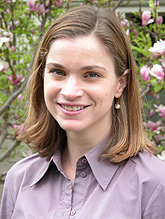Berkeleyan
Myriad perspectives on biological differences![]()
| 31 March 2005
 Leslea Hlusko (Wendy Edelstein photo) |
Next fall, when she teaches Human Biological Variation (IB 35AC), Hlusko will
employ a number of perspectives — historical, comparative, evolutionary,
biomedical, and cultural — “to help students understand the factors
that shape the biological diversity we see today. Ethnic and cultural variation
is superimposed on biological variation,” continues Hlusko, “and
it is useful for students to see that they are not necessarily linked.”
As someone who studies primate evolution, Hlusko views the information she packs
into IB 35AC as “one of the best services I can offer to the community
at large.” Misunderstandings about human differences, she explains, may
contribute to stereotypes, misguided political and social policies, and “just
bad interactions between people.”
Differences between humans, says Hlusko, in some cases “only run skin-deep.
Variations in traits we can easily see, such as skin color, hair texture, and
nose shape, may cluster together, but other features — lactose intolerance,
fingerprint patterns, blood types — do not always correlate with them.” Hlusko
designed the course to give students that perspective, “so that they can
decide for themselves whether there are valid races or not.”
Hlusko notes that “there are no textbooks” for this sort of course.
Her syllabus includes readings from anthropologist Stephen Jay Gould’s
The Mismeasure of Man, Matt Ridley’s Genome: The Autobiography of a Species,
articles about evolution, and excerpts from Jared Diamond’s best-selling
book Guns, Germs, and Steel to round out a discussion on biology, politics, and
economics.
The course will culminate in an examination of current events, with a look at
the intersection of science and politics. Hlusko cites as an example last year’s
California ballot initiative in which voters were asked to decide whether the
state should collect information about its citizens’ racial or ethnic makeup.
“I don’t think we can let people graduate from college without some
understanding of the implications of human biological variation on biomedical
research, genetics, and evolution, and how they all tie together,” asserts
Hlusko. After all, she notes, Berkeley students will “hopefully go on to
become this country’s leaders. Even if the future graduates aren’t
making policy decisions they will be making important choices in the voting booth.”

